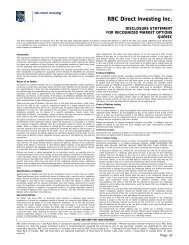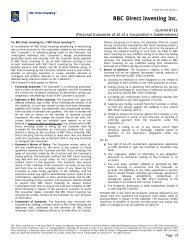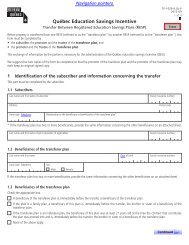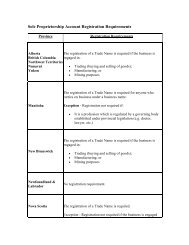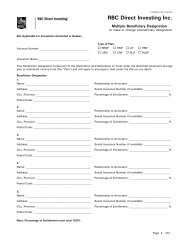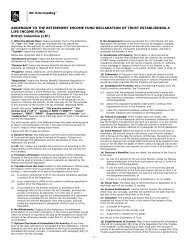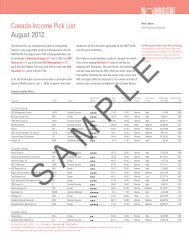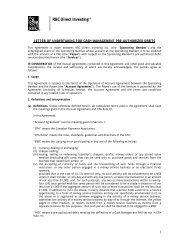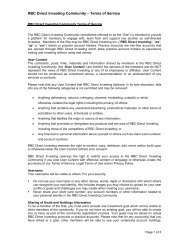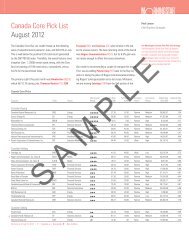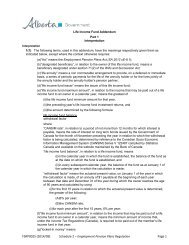View Sample PDF - RBC Direct Investing
View Sample PDF - RBC Direct Investing
View Sample PDF - RBC Direct Investing
Create successful ePaper yourself
Turn your PDF publications into a flip-book with our unique Google optimized e-Paper software.
Regional outlook – U.S. • Ray Mawhinney • Brad Willock, CFA<br />
which should help stimulate their<br />
economies during the second half of<br />
this year.<br />
In the near term, the prospect of a<br />
Greek exit from the Eurozone will<br />
likely keep markets from making too<br />
much progress. In the medium term,<br />
U.S. markets will be influenced by the<br />
presidential elections scheduled for<br />
November and the expiration of tax<br />
cuts and other stimulus measures on<br />
January 1, 2013. This so-called fiscal<br />
cliff could hurt gross domestic product<br />
to the tune of 3% to 4% if all items<br />
are allowed to expire. We anticipate<br />
significant anxiety surrounding this<br />
issue, but believe that the fiscal drag<br />
will ultimately amount to 1% to 2% of<br />
GDP. We are positioned defensively,<br />
but intend to take advantage of any<br />
market weakness over the next few<br />
quarters to increase our exposure to<br />
economically sensitive companies<br />
that exhibit solid profitability and<br />
good prospects for long-term dividend<br />
growth.<br />
The tone of recent U.S. economic data<br />
has been much better, as employment,<br />
housing and consumer spending are<br />
all showing signs of improvement. In<br />
terms of the job market, unemployment<br />
claims remain in a downtrend and<br />
surveys indicate that companies are<br />
planning to boost hiring. In the housing<br />
market, the improvement is even more<br />
broad-based and impressive, as the<br />
number of homes for sale has returned<br />
to pre-crisis levels and the median<br />
asking price is rising thanks to record<br />
affordability. Rents are increasing<br />
at a 10% clip in many regions and,<br />
combined with record-low mortgage<br />
rates and the drop in home prices,<br />
investors and first-time homeowners<br />
have stepped back into the market.<br />
Given that the employment and<br />
housing markets are healing, the U.S.<br />
consumer is again starting to contribute<br />
to economic growth. Consumer<br />
confidence is at cycle highs, credit is<br />
expanding and household formation is<br />
finally on the upswing after 6 ½ years<br />
of a flat or declining trend. While the<br />
improvement in household formation is<br />
not great, the trend appears to be selfsustaining<br />
enough to have encouraged<br />
1 million people to get out of their<br />
parents’ basement and into their own<br />
place. It’s about time!<br />
Despite the gyrations in the<br />
macroeconomy, corporate<br />
fundamentals remain in good shape.<br />
Stocks are attractive in valuation terms.<br />
They trade at a roughly 5% trailing freecash-flow<br />
yield and 12 times this year’s<br />
estimated earnings. Interestingly, more<br />
than 50% of the stocks in the S&P 500<br />
index sport dividend yields greater<br />
than the yield on the 10-year Treasury<br />
bond. The only other time that this<br />
happened was in March 2009 - near<br />
the market low. While this seems worth<br />
exploiting, the real attraction of the<br />
stock market lies in the fact that the<br />
payout ratio is at an all-time low, while<br />
cash levels and profitability are at alltime<br />
highs. The potential for companies<br />
to raise dividends meaningfully over<br />
time is extraordinary.<br />
While the focus of the media and<br />
most investors is on near-term<br />
political events in Europe, there<br />
are many exciting long-term<br />
developments occurring in the U.S.<br />
The energy industry is undergoing a<br />
supply revolution, as it harnesses<br />
new technologies that will lay the<br />
groundwork for growing surpluses<br />
in crude oil, natural-gas liquids<br />
and natural gas. This has profound<br />
implications for employment,<br />
economic growth, the trade deficit,<br />
the U.S. dollar and energy security.<br />
In particular, U.S. manufacturing<br />
is enjoying a renaissance due to<br />
this new energy-cost advantage,<br />
relatively high productivity growth and<br />
subdued labour-cost growth. In China,<br />
manufacturing wages have been rising<br />
at a 20%-plus rate over the past several<br />
years. Add in China’s strengthening<br />
currency and higher shipping costs,<br />
and it is no longer a clear-cut decision<br />
to move manufacturing across the<br />
Pacific Ocean. In fact, dozens of<br />
companies have announced plans to<br />
bring capacity back to the U.S. A road<br />
to a more energy-secure U.S. will take<br />
years to play out and policymakers<br />
could always derail the momentum, but<br />
the potential is huge and needs to be<br />
part of investors’ analytical framework.<br />
SAMPLE<br />
The global investment outlook <strong>RBC</strong> INVESTMENT Strategy coMMITTEE Summer 2012 I 55



